#Indian Leopard Attack
Explore tagged Tumblr posts
Text


LEOPARD VERSUS MAN -- MAN VERSUS LEOPARD: WHEN ANIMALS ATTACK.
PIC(S) INFO: Part 2 of 2 -- Spotlight on the two best shots for last -- A forest guard prepares to shoot a rampaging leopard after he and his colleagues were attacked in the village of Prakar Nagash, India. Officials made several attempts to tranquilize the animal – many were injured in the process. 📸: Diptendu Dutta.
OVERVIEW: "A leopard strayed into Prakash Nagar village in India and mauled several people, including three guards, before being caught by forest officials. The animal, which suffered injuries caused by knives and batons, died later in the evening at a veterinary centre."
-- THE GUARDIAN, July 20, 2011
Source: www.theguardian.com/world/gallery/2011/jul/20/leopard-attacks-villagers-india.
#When Animals Attack#Leopard Attack#Wild Leopard Attack#Prakar Nagash India#Indian Leopard#Feral Cats#Wild Cats#Big Cats#Wildlife#Photography#Animals#India#Leopard#Animal Attack#Nature#Indian Leopard Attack#Prakash Nagar India#Indian Subcontinent#Prakar Nagash#Prakash Nagar
2 notes
·
View notes
Text
CoD Baddies as Bears!
What if the bad guys were also bears! Part 3
See part 2 and 1 for 141 and good guys as bears
Even more bear facts because bears are love, bears are life. 🐻🐻❄️🧬
Makarov: Ussuri Brown Bear "Russian Grizzly Bear"
Ursus arctos lasiotus
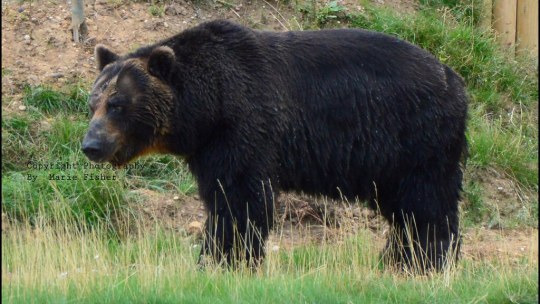
Also known as the Ezo Brown bear or Black Grizzly bear, this subspecies of Eurasian Brown Bear is one of the largest, with some individuals approaching the Kodiak Bear in size.
Similar to the Kamchatka Brown Bear, it differs with an elongated skull, longer nasal bones, elevated forehead and is darker in colour with some individuals being pure black.
Siberian (Amur) tigers and other bears are it's only natural predators, with documented tiger and bear interspecific competitions. Ussuri brown bears will often scavenge tiger kills and or kill smaller tigers, while Tigers are known to hunt young and sub-adult bears (bears making a significant portion of their diet).
Graves: Louisiana Black Bear
Ursus americanus luteolus

A subspecies* of the American Black Bear (U. a. americanus), the Louisiana Black Bear has been historically found in Louisiana, Mississippi, East Texas and Arkansas.
It is not substantially different from the American Black Bear, though it has a longer, flatter, narrower skull and larger molars in comparison. It's colouration is typically black, though some individuals have been known to be brown/red-brown cinnamon. It is Louisiana's official state mammal.
*The validity of this subspecies has been repeatedly debated.
Valeria: Sloth Bear "Indian Bear"
Melursus ursinus
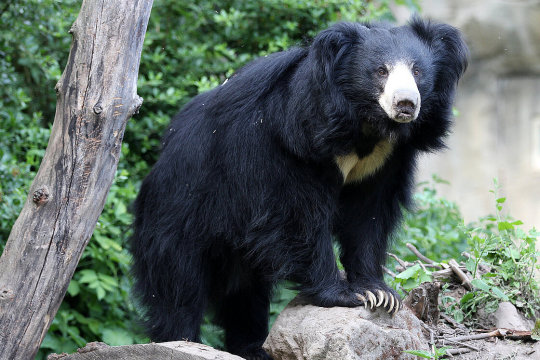
A native species to the Indian Subcontinent, this medium sized bear feeds on ants, termites and fruit. It is also called the "labiated bear" due to its long lower lip and palate which is used to eat insects.
It's fur is pure black aside from the white "Y" or "V" patch on its chest though this can be absent in some individuals. They are similar in size with the Asian Black Bear though distinguished with it's shaggy mane, white 'sickle' claws, and rangier build.
This species is the most aggressive to humans with the largest number of recorded attacks due to a combination of close human cohabitation and a theorised predisposition to aggressive behaviour from constant attacks by tigers, leopards, rhinos and elephants.
Captain Williamson in his Oriental Field Sports (1819) wrote of how sloth bears rarely killed their human victims outright, but would suck and chew on their limbs till they were reduced to bloody pulps.
They are not known to be man eaters despite attacking humans. One individual in Mysore (Mysuru), India was recorded to have killed at least 12 people and mutilated 24 before it's death in 1957.
Shepherd: Koala "Koala Bear"**
Phascolarctos cinereus
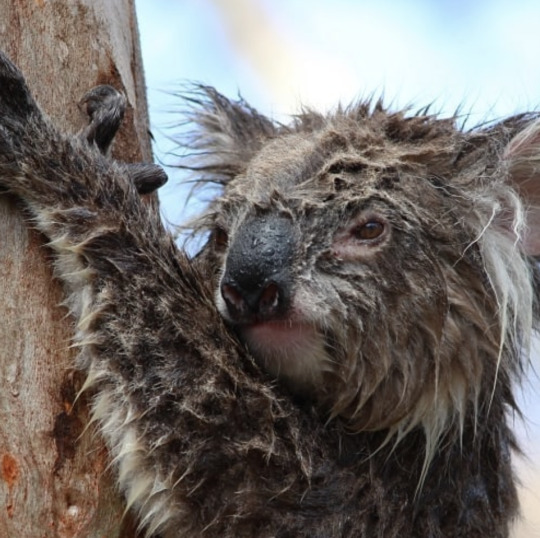
**not a bear
An arboreal marsupial native to Australia that feeds primarily on Eucalyptus leaves. Koalas are asocial with bonding only taking place between mothers and dependant offspring. They are largely sedentary and will sleep upwards to 20 hours a day.
The word "koala" came from the Dharug word "gula" - no water. The 'u' sound was originally written phonetically as 'oo' and then became 'oa'. The three syllable pronunciation may be erroneous as a result.
White settlers adopted the 'koala' indigenous loan word in reference to the animal, where it was also referred to as, the "native bear", or the "koala bear" due to its supposed bear-ish resemblance.
+
Info from Wikipedia. Please let me know if I screwed up somewhere. 🐻
#cod mwiii#cod mwii#call of duty modern warfare#call of duty#vladimir makarov#cod makarov#phillip graves#graves cod#valeria garza#valeria mw2#general shepherd#bears#bear facts#cod mw2#cod mw3
49 notes
·
View notes
Text
MOVIES WITH MEN IN UNDERWEAR (This is outdated- website shutdown early 2000’s)
“G”
Galaxy Quest (1999) Sci-fi comedy. "Commander Peter Quincy Taggart" (Tim Allen) is at home, asleep on the couch, hungover and trouserless, when awestruck friendly aliens come to visit.
Garp A locker room scene with several unidentified actors in jocks.
Georgy Girl Alan Bates in a couple of shots in his Jockey briefs.
Gharwali Baharwali (1998) Indian musical comedy. An overweight, middle-aged manager ritually humiliated, being stripped, head-shaved and left as a beggar in his underwear (white undershirt and big boxers).
Ghost Dog: The Way of the Samurai (1999) Crime drama. Ghost Dog robs a couple at gunpoint off-camera, and they emerge into the street, the woman in her skimpy bra and panties and the man in his boxers.
Ghostbusters (1984) I can't believe that there has been no mention of the first underwear scene in a movie that I ever came across. Ray Stanz (played by Dan Ackroyd) is having a dream in which this female ghost is hovering above his bed moments before she vanishes into thin air. He looks around, obviously perplexed, and then his belt gets undone; the button on his pants is next, instantaneously followed by the unzipping of his zipper and then, his pants are opened. Voila! White briefs.
Gig, The (1985) Drama. A charming film, and including some of the middle-aged leads in their underwear.
Gimme an 'F' (1984) One of the main characters strips down to his white briefs and dances around the shower room. He does this for quite a while and gets them very wet.
Girl 6 (1996) Comedy. Phone-sex caller, a slim, fortyish black man, acts out his baseball-hitter fantasy in a room painted up as a stadium, wearing a baseball helmet and a white jock strap.
Girls Are for Loving (1973) Crime movie. At some point, just about everybody ends up naked and bound in one way or another. One interesting scene: two evil henchman have been captured and bound nearly naked with their hands above their heads.
Glitz (1988) (TV) Action/thriller. An attacker fires at Jimmy Smits, who's in bed with Linda Moon at the time. Clad only in his briefs, Smits chases after the guy, out into the street.
Gloria (1999) Thriller. "About 20 minutes into the film (which doesn't compare to the original), there is a cool scene where Sharon Stone forces her criminal ex-boyfriend and his henchmen to strip naked at gunpoint. Rear nudity only, but very intense scene. Every guy seems to have on a different type of undies. I watched the video with my roommate and she couldn't stop laughing at the guy with the leopard print briefs".
Go (1999) Close-up shots of Scott Wolf in his briefs, being wired for sound with a hidden transmitter attached to his thigh. Also, another guy putting on his dark boxer shorts in a suggestive scene.
Gods and Monsters (1998) In one scene, Whale mischievously makes a flamboyant, young male reporter remove an article of clothing for every question that he answers (until the man's down to his underwear).
Gods Must Be Crazy, The (1980) Comedy. Startled by a warthog while taking off his wet clothes, guy flees pants-down in his red briefs.
Going Ape! (1981) Tony Danza running around in a hospital gown and his briefs ... at end of movie.
Gold Rush Boys (XXX) ****my favorite*** This porn-vid is chock full of hot young "pioneer" men in union suits having fun in an all-male bordello. There are quite a few tender scenes (kissing, etc.) One gorgeous guy spends most of the movie falling out of his maroon union suit. Very sexy!! (Sorry I don’t know which studio made this - but I’m sure of the title.)
Gone Fishin' (1997) A witless comedy that at the very end has both Joe Pesci and Danny Glover caught with their pants around their ankles, showing their colorful boxer shorts.
Good Burger (1997) Mild, juvenile comedy. Disguised in drag to spy on a rival burger operation, the heroes are caught and unmasked - revealing the chubby one in his blue and white plaid boxer shorts, and the slim one embarrassed to be discovered in drag all the way down to women's underwear.
Good Man in Africa, A (1994) Colin Friels wears comic loud printed boxer shorts, as Diana Rigg sews his costume. Later, he must exchange every piece of clothing he has on with John Lithgow - even down to boxers and briefs being switched.
Good Will Hunting (1997) Drama. Matt Damon in white boxers in scene with Minnie Driver.
Goodbye Bird, The (1993) Chris Pettiet. His mother knocks on the the door...he gets up wearing only blue silk boxer shorts - you can see his pecker bouncing in his boxers.
Goodbye, Columbus (1969) Michael Meyers in boxer shorts, has a vapid conversation with Richard Benjamin. He is a fairly well-built jock with a rather empty mind.
GoodFellas (1990) Crime drama. Gangsters go to kill their oversleeping driver (Tony Sirico). Unsuspecting, in his yellow undershirt and briefs, he opens the door to them.
Gotcha! (1985) Anthony Edwards standing in Jockeys, briefly. Short scene but NICE.
Gotham (1988) (TV) Thriller. Two scenes with Tommie Lee Jones in a white A-shirt and white boxer shorts, one early in the movie when J.B. White wakes him up, and another later in the film while making love to Virginia Madsen.
Graduate, The (1967) A young preppy-looking Dustin Hoffman gets seduced by Mrs. Robinson, and winds up in bed with her in his white trim-cut boxer shorts.
Grandview, U.S.A. (1984) Drama. C. Thomas Howell spends the night with Jamie Lee Curtis. In the morning, he's awakened when the her boyfriend arrives ... in his trim plaid boxer shorts, he has to get to his pants on the other side of the room, but picks the wrong moment and is seen through the doorway. There is also a scene with Patrick Swayze in patterned boxers, and two scenes with Troy Donahue in printed boxers.
Grease ?
Great Balls of Fire! (1989) Dennis Quaid as Jerry Lee Lewis parades around this movie in loudly printed full-cut boxer shorts from time to time.
Great Santini, The (1979) Michael O’Keefe (most recently on Roseanne) plays a high school student who has Robert Duvall, military officer, for a father. Dad wakes O’Keefe up in the early morning of his 18th birthday to give him his present. O’Keefe is wearing nothing but white briefs.
Greedy (1994) Michael J. Fox in grey Calvins.
Green Mile, The (1999) Drama. Crazy death row inmate "Wild Bill" (Sam Rockwell) in a union suit.
Gremlins 2 (The New Batch) (1990) Mr. Clamps walks outta bathroom in his office in a pair of blue boxers, he then puts on a pair of pants (too bad).
Grim Prairie Tales (1990) Creepy short story compilation. In one segment, an old-west gunman is seen for a moment in his white undershirt and briefs.
Gross Anatomy (1989) Matthew Modine in bed in white briefs and maroon T-shirt.
Guarding Tess (1994) A minor Nicolas Cage movie with Shirley McLaine. Brief scene of Nick interrupted as he is sitting on the john taking a dump, with pants down and colored boxers very visible around his knees.
Guelwaar (1992) Drama. In an early scene at a police station, watch closely for two prisoners, stripped to their white briefs, crossing the scene in the background.
Guide for the Married Man, A (1967) Joey Bishop is caught with his pants down by his wife. Seen in his white full-cut boxers and with a pretty girl, Joey denies it all.
Guns of Navarone, The (1961) Classic WWII action. Scene of Germans officers being stripped for their uniforms.
3 notes
·
View notes
Text

Lakeshore Records will release a soundtrack album for the Apple TV+ documentary series Big Beasts. The album features selections of the show’s original music composed by Ruth Barrett (Bodyguard, Victoria, Sanditon, The Terminal List, Collateral, Harry Brown). The soundtrack will be released digitally this Friday, April 21. Check back on this page for the streaming/download link. Big Beasts is executive produced by Tom Hugh-Jones, Martha Holmes & Grant Mansfield and takes audiences on a journey around the globe, from freezing poles to tropical rainforests, to meet nature’s most captivating giants. The 10-parter narrated by Tom Hiddleston was filmed across seventeen countries and captures rare footage using specialized equipment and next-generation filming technique. The series will premiere on April 21 exclusively on Apple TV+.
Here’s the track list of the album:
. Ostrich in the Savannah (3:53) 2. Pacific Whales (2:41) 3. Mother Octopus – Ruth Barrett & Claudio Olachea (3:00) 4. Okavango Flood (2:02) 5. Elephant Calf Survival (2:16) 6. Gorilla Makumba (1:35) 7. Magnificent Mandrills – Ruth Barrett & Claudio Olachea (1:29) 8. Enter the Congo Bai (1:49) 9. Giant Otters of the Pantanal – Ruth Barrett & Claudio Olachea (3:21) 10. Brazilian Anteater (2:39) 11. Orangutans of Borneo (3:04) 12. Proboscis Monkey – Ruth Barrett & Claudio Olachea (1:22) 13. Indian Tiger Kingdom – Ruth Barrett & Dom James (3:30) 14. King Cobras Duel – Ruth Barrett & Claudio Olachea (3:15) 15. Bearfight in the Rockies (2:25) 16. The Polar Bear’s Voyage (3:28) 17. Antarctic Elephant Seals (2:27) 18. Orca Attack – Ruth Barrett & Claudio Olachea (1:10) 19. The Albatross Learns to Fly – Ruth Barrett & Dom James (2:45) 20. Leopard Seal vs. Gentoo Penguin – Ruth Barrett & Claudio Olachea (1:57) 21. The Humpback Whale’s Miracle (2:28)
youtube
24 notes
·
View notes
Photo

Four years ago, I drew a picture of a shark-themed nativity scene. Last year I decided to sculpt the shark nativity. Due to extenuating circumstances I was unable to have it finished in time for Christmas. This year, I was able to display the complete shark nativity for the holidays.
Note: yes I did supplement the nativity set with goldfish. Next year I might use swedish fish.
Here is a breakdown of the different characters:
Angels: portrayed by angel sharks

Angel sharks are flat in shape because they are adapted to hide in the sand and ambush their prey.
Video: Angel Shark attack
Wise Men: Three Migratory Shark Species

(Left) Scalloped hammerheads once traveled the world’s oceans in schools of hundreds. Many shark species in general are endangered because of overfishing and the shark fin trade, but scalloped hammerheads have been hit particularly hard. One place where these great schools survive is in the eastern Pacific ocean, along the coasts of Central and South America.
(Center) Blue sharks live in temperate ocean waters globally. They mainly eat squid in the depths of the open ocean, but are often found at the surface feasting on dead whales. Blue sharks tagged off of Rhode Island, USA have been found near Africa on the far side of the Atlantic.
(Right) Great white shark migration has been the subject of satellite tag studies in recent years. A white shark tagged off of South Africa, named Nicole, traveled across the Indian Ocean to the west coast of Australia and then back to Africa again. White sharks in the north Pacific travel between the west coast of North America and Hawaii, converging in a location between the two places nicknamed ‘the Great White Cafe’.
Video: A white shark called Katherine
Shepherds: Blacktip Reef Sharks

Many species of sharks corral or ‘herd’ schools of fish into bait balls as a hunting behavior. Blacktip reef sharks, native to the Indo-Pacific, will chase fish swarms into the shallows and even risk beaching themselves.
Note: for fish I have used Goldfish(TM). In future years I may use other fishy snacks such as Swedish Fish.
The Holy Family: Zebra Sharks

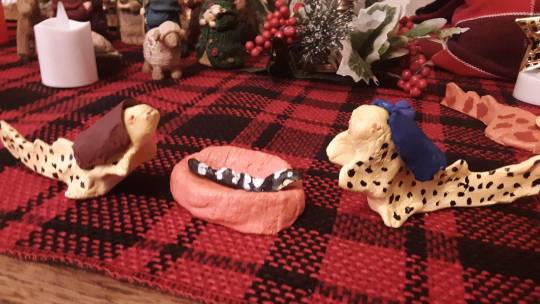
Zebra sharks in captivity are affectionate and even playful with aquarists. WIld zebra (or leopard) sharks are shy but very placid in temperament. Being the nicest of all nice sharks, zebra sharks were the ideal choice for the Holy Family.
There have been documented cases of female zebra sharks producing pups without mating, a process scientifically called parthogenesis. In all documented cases, however, the pups never live longer than six months.(This one ofc we know will be different ;))
Zebra sharks get their name from the zebra-like striped skin of the pups, as you can see with baby Jesus in the center.
Zebra sharks are native to the Indo-Pacific, and they are found as far west in the Indian Ocean as the coasts of the Arabian peninsula
#my shark art#shark nativity#nativity#merry christmas#religious#happy holoidays#@marinebiologyshitposts how's that for a sharky christmas?
18 notes
·
View notes
Text
Events 6.22
217 BC – Battle of Raphia: Ptolemy IV Philopator of Egypt defeats Antiochus III the Great of the Seleucid kingdom. 168 BC – Battle of Pydna: Romans under Lucius Aemilius Paullus defeat Macedonian King Perseus who surrenders after the battle, ending the Third Macedonian War. 813 – Battle of Versinikia: The Bulgars led by Krum defeat the Byzantine army near Edirne. Emperor Michael I is forced to abdicate in favor of Leo V the Armenian. 910 – The Hungarians defeat the East Frankish army near the Rednitz River, killing its leader Gebhard, Duke of Lotharingia (Lorraine). 1527 – Fatahillah expels Portuguese forces from Sunda Kelapa, now regarded as the foundation of Jakarta. 1593 – Battle of Sisak: Allied Christian troops defeat the Ottomans. 1633 – The Holy Office in Rome forces Galileo Galilei to recant his view that the Sun, not the Earth, is the center of the Universe in the form he presented it in, after heated controversy. 1774 – The British pass the Quebec Act, setting out rules of governance for the colony of Quebec in British North America. 1783 – A poisonous cloud caused by the eruption of the Laki volcano in Iceland reaches Le Havre in France. 1807 – In the Chesapeake–Leopard affair, the British warship HMS Leopard attacks and boards the American frigate USS Chesapeake. 1813 – War of 1812: After learning of American plans for a surprise attack on Beaver Dams in Ontario, Laura Secord sets out on a thirty kilometres (19 mi) journey on foot to warn Lieutenant James FitzGibbon. 1839 – Cherokee leaders Major Ridge, John Ridge, and Elias Boudinot are assassinated for signing the Treaty of New Echota, which had resulted in the Trail of Tears. 1870 – The United States Department of Justice is created by the U.S. Congress. 1893 – The Royal Navy battleship HMS Camperdown accidentally rams the British Mediterranean Fleet flagship HMS Victoria which sinks taking 358 crew with her, including the fleet's commander, Vice-Admiral Sir George Tryon. 1897 – British colonial officers Charles Walter Rand and Lt. Charles Egerton Ayerst are assassinated in Pune, Maharashtra, India by the Chapekar brothers and Mahadeo Vinayak Ranade, who are later caught and hanged. 1898 – Spanish–American War: In a chaotic operation, 6,000 men of the U.S. Fifth Army Corps begins landing at Daiquirí, Cuba, about 16 miles (26 km) east of Santiago de Cuba. Lt. Gen. Arsenio Linares y Pombo of the Spanish Army outnumbers them two-to-one, but does not oppose the landings. 1907 – The London Underground's Charing Cross, Euston and Hampstead Railway opens. 1911 – George V and Mary of Teck are crowned King and Queen of the United Kingdom of Great Britain and Ireland. 1911 – Mexican Revolution: Government forces bring an end to the Magonista rebellion of 1911 in the Second Battle of Tijuana. 1918 – The Hammond Circus Train Wreck kills 86 and injures 127 near Hammond, Indiana. 1940 – World War II: France is forced to sign the Second Compiègne armistice with Germany, in the same railroad car in which the Germans signed the Armistice in 1918. 1941 – World War II: Nazi Germany invades the Soviet Union in Operation Barbarossa. 1942 – World War II: Erwin Rommel is promoted to Field Marshal after the Axis capture of Tobruk. 1942 – The Pledge of Allegiance is formally adopted by US Congress. 1944 – World War II: Opening day of the Soviet Union's Operation Bagration against the Army Group Centre. 1944 – U.S. President Franklin D. Roosevelt signs into law the Servicemen's Readjustment Act of 1944, commonly known as the G.I. Bill. 1945 – World War II: The Battle of Okinawa comes to an end. 1948 – The ship HMT Empire Windrush brought the first group of 802 West Indian immigrants to Tilbury, marking the start of modern immigration to the United Kingdom. 1948 – King George VI formally gives up the title "Emperor of India", half a year after Britain actually gave up its rule of India. 1962 – Air France Flight 117 crashes on approach to Pointe-à-Pitre International Airport in Guadeloupe, killing 112 people. 1965 – The Treaty on Basic Relations between Japan and the Republic of Korea is signed. 1966 – Vietnamese Buddhist activist leader Thích Trí Quang was arrested as the military junta of Nguyen Cao Ky crushed the Buddhist Uprising. 1969 – The Cuyahoga River catches fire in Cleveland, Ohio, drawing national attention to water pollution, and spurring the passing of the Clean Water Act and the creation of the Environmental Protection Agency. 1978 – Charon, the first of Pluto's satellites to be discovered, was first seen at the United States Naval Observatory by James W. Christy. 1979 – Former Liberal Party leader Jeremy Thorpe was acquitted of conspiracy to murder Norman Scott, who had accused Thorpe of having a relationship with him. 1984 – Virgin Atlantic launches with its first flight from London to Newark. 1986 – The famous Hand of God goal, scored by Diego Maradona in the quarter-finals of the 1986 FIFA World Cup match between Argentina and England, ignites controversy. This was later followed by the Goal of the Century. Argentina wins 2–1 and later goes on to win the World Cup. 1990 – Cold War: Checkpoint Charlie is dismantled in Berlin. 2000 – Wuhan Airlines Flight 343 is struck by lightning and crashes into Wuhan's Hanyang District, killing 49 people. 2002 – An earthquake measuring 6.5 Mw strikes a region of northwestern Iran killing at least 261 people and injuring 1,300 others and eventually causing widespread public anger due to the slow official response. 2009 – A Washington D.C Metro train traveling southbound near Fort Totten station collides into another train waiting to enter the station. Nine people are killed in the collision (eight passengers and the train operator) and at least 80 others are injured. 2012 – Paraguayan President Fernando Lugo is removed from office by impeachment and succeeded by Federico Franco. 2012 – A Turkish Air Force McDonnell Douglas F-4 Phantom II fighter plane is shot down by the Syrian Armed Forces, killing both of the plane's pilots and worsening already-strained relations between Turkey and Syria. 2015 – The Afghan National Assembly building is attacked by gunmen after a suicide bombing. All six of the gunmen are killed and 18 people are injured. 2022 – An earthquake occurs in eastern Afghanistan resulting in over 1,000 deaths.
2 notes
·
View notes
Photo
@eldriwolf sent me this, and I immediately thought of the Indian bagh nakh "tiger-claw" weapon, which isn't usually articulated or as realistic - for a given value of realism - but was a very nasty piece of kit.
The basic version was a steel bar with two rings for index and pinkie fingers, and four steel claws for ripping into an enemy's soft parts - probably neck and stomach, where there were no awkward bones and the result would be more effective.


These simple versions had an extra advantage of being easy to conceal...


...and sometimes the finger-rings would be gilded and decorated with gems as if they were just jewellery.
Okay, maybe quite a lot of jewellery.

I bet that if timing and location were organised properly, political assassination could be passed off - in honest belief or for convenience - as the victim having encountered a real tiger.
"But where are the marks of the tiger's teeth?" That too could be arranged:


These double daggers have proper flattened-diamond blade profiles, and their points are too close for a full-grown tiger or leopard - but (fiction-writer imagination at work) there's no reason why a special-purpose one couldn't have been made with realistic separation and correct tooth-spike shape.
The modern era has seen plenty of convenient "accidents" and "suicides"(what writer Len Deighton calls XPD or Expedient Demise) so how good was Mughal-era CSI?
Or more correctly, when required by Certain Circumstances, how bad did it need to be?
If an Important Person announced: "Clearly a tiger did it. How sad. Too bad. Long live the new maharajah, my Dear Little Nephew", the best way for doubters to maintain good health would be agreement...
*****
There was another version which - if the "attacked by a wild beast" excuse was still used - came with a suggestion that tigers in that particular region were getting disturbingly smart. (Though pointing this out may not have been wise, see above...) :->


These are bichuwa bagh nakh, "scorpion-sting tiger claws", the dagger name deriving from its recurved blade shape resembling the business end of a scorpion's tail.

They were sometimes carried in combat, bichuwa bagh nakh in the left hand and a talwar (curved) or khanda (straight) sword in the right.
During close-quarter grappling the claws could rake and the dagger stab, while the finger-rings meant less risk of dropping it.


In the same way that many Indian weapons had "tacticool" add-ons - miniature pistols, axe-gun combinations, concealed daggers and so on - there were bagh nakh with more than just one extra blade...


...bagh nakh with extra folding blades and a knuckle-guard...

...and this articulated contraption which (IMO anyway) was for defence as well as attack.

*****
It was, like the much simpler two-ring-no-blades version, a lot less obvious than the first photo suggests...


...and since many Indian helmets were open-faced while others had face-protection only of mail...




...a surprise slap across the face might spoil any warrior's day.
The reason I think it also had a defensive purpose is the fairly thick metal palm and that little spur low down on it, almost certainly meant to stop a palm-blocked blade from sliding any further.

I'm not sure there's enough articulation for such a blade to be actually gripped tightly, but once trapped between spur and claws it could be twisted aside for long enough that a weapon in the other hand could attend to its wielder.
*****
Yet again: when creating a fantasy weapon for writing or RPG, do a search for whatever you have in mind, because it may well have been made for real a couple of centuries ago by an Indian weaponsmith demonstrating what he could do to advertise his skill, or just making some oddity in steel to see if it was possible... :->
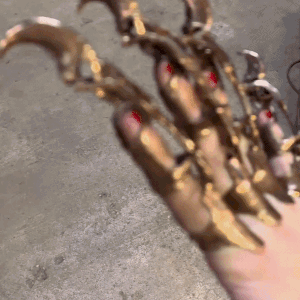

aerarius_metalworks
42K notes
·
View notes
Text
JD Vance, Trump’s newly selected vice presidential choice, is married to Usha Vance. Usha has been facing racist attacks because of her Indian heritage and the GOP assumption that being JD’s wife makes him softer on immigration. It's so surprising the Leopards Eating Faces Party would eat their faces too.
#jd vance#usha vance#gop#republicans#racism#leopards eating faces party#satire#funny#joke#comedy#us politics#USpol#politics#political
0 notes
Text
If you can, save the papers and schoolwork you do as a child, because reading them almost two decades later is hilarious and priceless- some of my personal favorite works (originally all in half cursive, half print because I was weird like that):
"A Good Carrer
I want to be a zoo keeper, I will take care of the cheetah and the sea lions. The cheetah's are carnivores and eat meat. You have to keep there exhibit clean and give them lots of toys to play with. Some cheetah's have pet dogs because the cheetahs are shy and they can get exercise with dogs, which is why I hate it when people say Cats VS. Dogs. Sea lions eat meat and like to swim. You must keep there water partially clean and you can throw some toys that float on the water. If the water is to clean it is not good for the sea lions because they don't swim in Chorline like we do. Sometimes they get fish frozen in ice blocks as toys."
~
"ZOO favorites
My favorite animal is the cheetah it has black spots on it's body and 2 black stripes going from it's eyes to it's nose. The spots are different from jaguars and leopards. My dad called a cheetah a leopard because he says he is stupid. They are the fastest mamal in the world. They can go 70 mph. They also have week jaws, so if they see lions and fight, the lion would probably win. But they are definitely a cool animal."
~
"Just the Place
Hey folks you should go to hawie. They got warm weather all year long. You can go to the beaches and lounge on the sunny beach all day with sunblock. You can swim in the water. You can try different foods and how to hula-hoop. This is definitely a good place to go."
[They should've paid me - I was doing free advertisement as a kid for a place I've never been 😂]
-
"SNakes are good
Dear friend I no you don't like snake but I am going to try and convince you to like by telling you three good things about snakes.
1. Snake's venom poison can be turned into medicin to give to people that were bitten by a snake.
2. They eat peskey rare and mice that we don't want in our house.
3. They control the population of there prey.
Also snakes are not slimy. I found a dead one and it was smooth like fingernails."
~
"Holiday Vacation
Over the holidays I went to this really fun children's museum. I pretended to work on a farm. Me and the other kids pretended that these green balls were grain. First we put them in this tiny called the screw carrier. The grown up then dropped in this thing that they fall in but you have to turn some levers. Then you put them in a bucket and put them in these three tubes. The one that I was putting the brain into led to a giant holder. When I was done I went over to these giant cow statues and opened the hatch to put the brain down. Then water came out of their udders."
~
"Describe a tepee
It is a mobile home for the native American indians. It has symbols on the outside and a flap. On the inside it has fur for carpets and beds and a bone backrest. It is made with many tall sticks that stick through the smoke hole at the top and buckskin with the fur shaved off the walls. An tepee usually has a fire inside it and that is why there is a smoke hole. That is how I like to describe a teppee.
P. S I wanted to tell that the native americans used a buffalo bladder for a water bottle.
P. PS These are for West native americans. I lived in New York and they had a thing called wigwam to live in and a long house of wood called a long house.
P. PPS I tried to make a tepee in the woods but my mother said I couldn't sleep in it because there are spiders at night."
~~~~
There was also a paper where I had to describe what happened on 9/11 but every time I mentioned terrorists, I spelled it, "therapists" ... So yes, apparently a bunch of therapists attacked on 9/11
1 note
·
View note
Text
I gotta wonder. like. how is usha vance feeling about all this? like kamala harris, she’s an indian american woman, and the party her husband is running as a vice presidential candidate for has been attacking harris’ credibility because she’s an indian american woman. if the republicans are saying anything negative about harris because of her race and gender, they’re implying the same things about the woman who would be second lady under their own party should they win. there are already far-right conspiracy theories about usha vance with regards to their “replacement theory” bs. we’ve seen trump making racist remarks about elaine chao- a member of his own cabinet- because she made statements against him after jan. 6. and if things go on the way they do, the more vance abandons whatever morals he used to have in order to social climb within the party, the worse his own wife is likely going to have it. my sympathy is limited for those in the “face eating leopards party,” but I can’t say it isn’t there at all.

Just a reminder the Republicans are a party filled with racists otherwise the house GOP wouldn't have to explicitly tell other republicans to not attack Kamala Harris based on her race or skin tone. Weren't the Republicans and other conservatives talking about judging people based on their character and not on the tone of their skin, guess those guys missed the memo? It's darkly funny they even have reign this in at all, despite all the criticisms you could have of the democratic party they've never have had to keep racism within the party in check for decades especially not now. So keep up the good fight and don't stop spreading awareness of project 2025 peeps, we have our democracy to save!
308 notes
·
View notes
Text




WHEN ANIMALS ATTACK -- RAGING LEAOPARD ON THE LOOSE EDITION.
PIC(S) INFO: Part 1 of 2 -- Spotlight on images of a Leopard attack upon villagers in India. 📸: Diptendu Dutta.
The following are image descriptions in the order they were listed:
A wild leopard prepares to pounce on a forest guard after it strayed into Prakash Nagar village in India.
Six people were mauled by the leopard before it was caught by forestry department officials.
The animal leaps on an armed forest guard in Prakash Nagar village, India.
Forest guards try to ensnare the leopard.
OVERVIEW: "A leopard strayed into Prakash Nagar village in India and mauled several people, including three guards, before being caught by forest officials. The animal, which suffered injuries caused by knives and batons, died later in the evening at a veterinary centre."
-- THE GUARDIAN, July 20, 2011
Source: www.theguardian.com/world/gallery/2011/jul/20/leopard-attacks-villagers-india.
#When Animals Attack#Animal Attack#India#Indian Leopard#Leopard#Leopard Attack#Animals#Nature#WildCats#Photography#Indian Leopard Attack#Feral Cats#Wildlife#Prakash Nagar India#Prakash Nagar#Big Cats
0 notes
Text
Vanishing Spots: Threats to the Indian Leopard
Silently pouncing on its prey and choking its windpipe, an extremely skilled predator roams in most of India. They have a higher hunting success rate than the mighty tiger. They prey on a large range of animals starting from hares to Nilgais. Here, I am mentioning the iconic spotted cat — the Indian Leopard.
The Indian leopard has strong legs and a long, well-formed tail, broad muzzle, short ears, small, yellowish-grey eyes, and light-grey ocular bulbs. Its coat is spotted and rosetted on a pale yellow to yellowish-brown or golden background, the spots fade toward the white underbelly and the insides and lower parts of the legs. Rosettes are most prominent on the back, flanks and hindquarters. The pattern of the rosettes is unique to each individual.
They are elusive, solitary, and largely nocturnal. It is known for its ability in climbing, and has been observed resting on tree branches during the day, dragging its kills up trees and hanging them there, and descending from trees headfirst. It is a powerful swimmer. It is very agile, and can run at over 58 kilometres per hour, leap over 6 m horizontally, and jump up to 3 m.
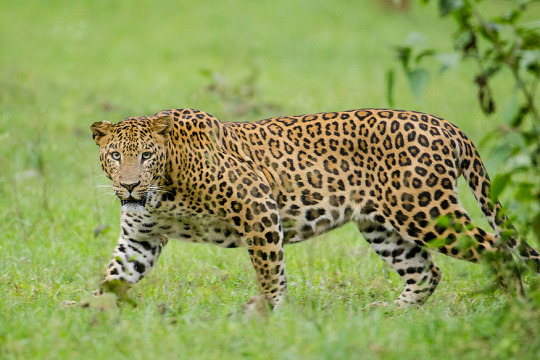
What are the main threats faced by the Indian Leopard?
Leopards, known for their adaptability and ability to coexist with humans, are facing numerous threats to their survival in India. Shrinking forests, poaching, and human-animal conflicts are among the major challenges that jeopardise the future of these majestic felines. This article aims to explore the threats facing Indian leopards, including habitat loss, poaching, and human-wildlife conflicts. Additionally, we will delve into the conservation efforts and preventive measures undertaken to protect this endangered species and promote their coexistence with human communities.
Habitat Loss and Fragmentation
One of the primary threats to Indian leopards is the loss and fragmentation of their natural habitat. Rapid deforestation, urbanisation, and expanding agricultural activities are diminishing the forests and reducing the prey base for leopards. As their habitat shrinks, leopards are compelled to venture into human settlements in search of food and shelter. This not only increases the chances of conflicts with humans but also exposes them to fatal road accidents as they navigate through urban areas. The encroachment of human activities into leopard habitats further disrupts their natural behaviour and ecological balance.
youtube
Poaching
Poaching poses a significant threat to Indian leopards, despite their protected status under the Wildlife Protection Act of 1972. Leopard skins, bones, and other body parts are in demand for their supposed medicinal properties and as luxury items. The illegal wildlife trade operates in various parts of the country, driven by the lucrative market for leopard products. Unfortunately, the enforcement of laws against poaching has been inadequate, leading to a low conviction rate and continued poaching activities. The lack of attention and concern for leopard poaching compared to high-profile cases involving tigers and rhinos further exacerbates the problem.
Human-Wildlife Conflict
Human-leopard conflict is a significant challenge for conservation efforts. In rural areas, leopards often come into conflict with villagers due to predation on livestock or, in rare instances, attacks on humans. Retaliatory killings by villagers seeking to protect their livelihoods or as acts of revenge are a common occurrence. Moreover, leopard cubs born in sugarcane fields face vulnerability when their mothers run away in fear of humans during harvesting. These defenceless cubs become susceptible to being killed by humans or attacked by stray dogs. Falling into uncovered water wells also poses a risk to the lives of leopards.
How can the Indian Leopard be conserved?
Various organisations, government agencies, and NGOs are actively involved in conserving Indian leopards and addressing the threats they face. They have made significant contributions to protecting leopards from harm and rehabilitating them in the wild. These organisations work on awareness campaigns, education, and community engagement to foster a better understanding of leopards’ ecological importance and promote their coexistence with humans.
To mitigate human-leopard conflicts, measures such as enforcing stringent traffic laws near wildlife-sensitive areas, establishing wildlife corridors, and implementing early-warning systems can reduce the chances of fatal incidents involving leopards and humans. It is crucial to increase awareness among local communities about the importance of leopard conservation and provide them with tools and knowledge to prevent conflicts. Additionally, forest departments need to strengthen their efforts in patrolling, monitoring, and prosecuting offenders involved in poaching and illegal wildlife trade.
We at Think Wildlife Foundation recently launched our Livelihoods for Conservation project to provide alternative, sustainable livelihoods to the communities living with wildlife. This is with the aim to incentivize conservation while uplifting these communities economically. You can purchase merchandise from these communities here!
Written by: Samarth Jain
Originally published at https://thinkwildlifefoundation.com on July 6, 2023.
0 notes
Text
The Most Endangered Animals in India
India is home to a rich diversity of wildlife, with over 500 species of mammals, 1,300 species of birds, 700 species of reptiles and 2,000 species of fish.
However, many of these animals are facing the threat of extinction due to habitat loss, poaching, climate change and human-wildlife conflict.
According to the International Union for Conservation of Nature (IUCN), India has 199 species of plants and animals that are critically endangered, meaning they have a very high risk of disappearing from the wild in the near future.
In this article, we will look at some of the most endangered animals in India and what is being done to protect them.
Bengal Tiger

The Bengal tiger is the national animal of India and one of the most iconic symbols of its wildlife. It is also the largest and most powerful of all the big cats, with an average weight of 200 kg and a length of 3 meters.
Bengal tigers are found in various habitats across India, from forests and grasslands to mangroves and wetlands. They are apex predators that feed on deer, wild boar, buffalo and other large animals.
However, the Bengal tiger is also one of the most endangered animals in India, with around 3,000 individuals left in the wild. The main threats to its survival are poaching for its skin and body parts, which are used in traditional medicine and as trophies, habitat loss due to deforestation and development, and human-tiger conflict, which occurs when tigers attack livestock or people.
To save the Bengal tiger from extinction, several conservation efforts have been launched, such as Project Tiger, which was started in 1973 by the Indian government to create tiger reserves and protect their habitats. Other initiatives include anti-poaching patrols, community awareness programs, wildlife corridors and translocation of tigers to new areas.
Asiatic Lion

The Asiatic lion is a subspecies of lion that is native to Asia and once roamed from Turkey to India.
However, due to hunting and habitat loss, it was reduced to a single population in the Gir Forest National Park in Gujarat, India. The Asiatic lion is smaller than its African cousin, with a larger tail tuft and a distinct belly fold.
It lives in groups called prides that consist of one or two males and several females and cubs. It feeds on deer, antelope, cattle and other prey.
The Asiatic lion is also an endangered animal in India, with only about 500–650 individuals left in the wild. The main threats to its survival are poaching for its bones and claws, which are used in traditional medicine and as ornaments, habitat loss due to agriculture and mining, and disease outbreaks such as the canine distemper virus.
To conserve the Asiatic lion from extinction, several conservation efforts have been implemented, such as Project Lion, which was launched in 1972 by the Indian government to protect the Gir Forest and its wildlife.
Other measures include vaccination campaigns, habitat restoration, compensation schemes for livestock losses and relocation of lions to new areas.
Snow Leopard

The snow leopard is a rare and elusive cat that lives in the high mountains of Central and South Asia. It has a thick fur coat that ranges from grey to yellowish-brown with black spots and rosettes.
It has a long tail that helps it balance on rocky terrain and a small head with large eyes and ears that help it detect prey. It feeds on wild sheep and goats, marmots, hares and other small animals.
The snow leopard is also an endangered animal in India, with only about 4,080–6,590 individuals left in the wild. The main threats to its survival are poaching for its fur and bones, which are used in traditional medicine and as clothing, habitat loss due to climate change and human encroachment, and human-snow leopard conflict, which occurs when snow leopards kill livestock or attack people.
To protect the snow leopard from extinction, several conservation efforts have been undertaken, such as Project Snow Leopard, which was initiated in 2009 by the Indian government to create snow leopard conservation areas and monitor their population.
Other actions include anti-poaching patrols, community education programs, livestock insurance schemes and transboundary cooperation with neighbouring countries.
Read More About The Wildlife
10 Funny-Looking Animals that You Should Know About
Behind the Numbers: Understanding the Tiger Census Process
Why Elephants May Not Exist in the Future?
India’s Remarkable Journey in Wildlife Protection
0 notes
Text
TIL: Zhu Youcheng is the only emperor in Chinese history, to be married to one wife and remain faithful to her, having no concubines. He was a hardworking emperor, lowering taxes, reducing spending, and demonstrating tolerance for Muslims. His son, however, had a haram so large, some starved.
Flares117 OP · 6 mo. ago He was regarded as one of the greatest emperors working hand and hand with officials. It was noted that there was almost no palace intrigue by the eunuchs or power struggles.
His son was given the best education and teaching on how to follow in his father's footsteps, but he loved brothels and hated his wife https://en.wikipedia.org/wiki/Hongzhi_Emperor
He was a party boy with "The Zhengde Emperor took up a luxurious and prodigal lifestyle and indulged himself in women. It was said that he liked to frequent brothels and even created palaces called "Bao Fang" (豹房; literally "The Leopards' Chamber") outside the Forbidden City in Beijing initially to house exotic animals such as tigers and leopards for his amusement and then later used to house beautiful women for his personal enjoyment.[3] He also met Wang Mantang, one of his favorite consorts at a Bao Fang. On one occasion he was badly mauled while hunting tigers, and could not appear in court audiences for a month.[2] On another occasion he burned down his palace by storing gunpowder in the courtyards during the lantern festival.[2] His harem was so overfilled that many women starved to death due to lack of supplies.[4]"
Imagine having a haram so large, you dont have enough food for all your waifus

The Mongols had a LOT of conquerors though. There was only one Alexander, but there were dozens of great Mongol generals.And to make things better, the Mongol Empire coalesced at precisely the time when the Number 1 breaker of steppe empires, China, was in no position to fight them thanks to a horrible civil war and the dumbest goddamned Dynasty to ever rule the country.It also helped that the other great horse riding empire, the Muslims, were basically in pieces at the time. So the Mongols could easily defeat them one at a time.They weren't quite as lucky when fighting empires that were perfectly fine tho. The Indians beat them so easily that they barely even remember fighting them at all. The Vietnamese utterly humiliated them, hilariously so.
Song Dynasty. Idiots literally funded the Mongols after Genghis Khan died, which should have led to the empire collapsing, and then got attacked once the Jin had been destroyed by the Mongols.
Their own military also sucked, because the entire court was basically working for the enemies, and the generals constantly had to relay each battle's strategy to the court even when the battles were days away, which mean they almost always lacked any initiative.
If it had been literally ANY other dynasty, they could have finished the Mongols off. It's not like Genghis Khan was the first steppe conqueror China had faced. But the Song constantly kept snatching defeat from the jaws of victory, and ensured all of China got conquered by foreigners for the first time in history.
You have to be more specific. The basic story of China is about 6000 years of a cycle of a competent emperor coming to power, each successive emperor in the dynasty is worse than the last, it gets to a point where the emperor is a legendary assclown, horrible things happen to the Chinese people, and then a rebellion/coup happens and there’s a new emperor.
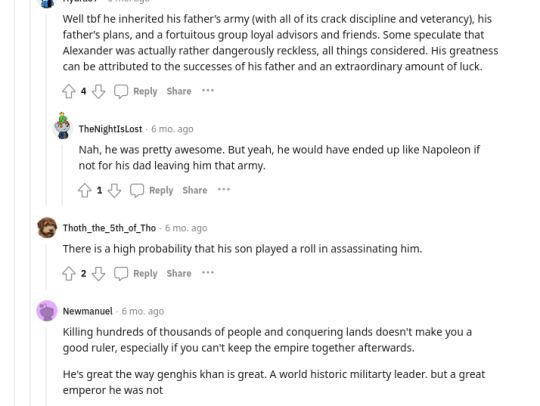
Those were not his accomplishments, those were just some of the tools he used to set up his accomplishments.I can't argue that if not for daddy dearest, Alex wouldn't have been able to start to become a great conqueror until he was in his 40s.

1 note
·
View note
Text
A stunning discovery made at a construction site in North Miami, Florida has made waves in local archaeology, with the unearthing of a figurine carved from the rare botallackite mineral, thought to date back to 1870.
The figurine, measuring just over an inch tall, depicts a leopard crouching in attack position and is believed to be the only known object made of botallackite, a mineral of the oxidized tin found in Cornwall, England. Scientists say the artifact is significant for illustrating the range of objects, resources and skills prevalent in 1870 North Miami.
The leopard, located in what was once the Indian camping ground of Mohees, is thought to be part of a larger collection of symbols used in the ceremonial burying ritual of Mohee warriors killed in battle and will help to paint a clearer picture of the culture of the indigenous people of the region during the period.
The figurine was discovered by construction workers who were demolishing a warehouse at the site when it was found embedded in the wall. Conservation and preservation techniques are now being employed to preserve the remarkable work of art and to understand more about its use.
Archaeologists have suggested that the botallackite figurine was used to symbolize the spirit of the warrior and to ensure safe passage to the afterlife. It is thought that the leopard, a great hunter, was a symbol of strength and courage for those who had fallen in battle.
The leopard botallackite figurine is now on display at the local history museum. Conservation and research into the object is ongoing, and archaeologists hope that further discoveries at the site will shed greater light onto the spiritual and cultural events of the Mohee trading post in 1870 North Miami.
0 notes
Text

Among the Flowers. Martin Gregus watched this polar-bear cub playing in a mass of fireweed on the coast of Hudson Bay, Canada. Every so often, the cub would take a break from its fun, stand on its hind legs, and poke its head up above the high flowers to look for its mother. © Martin Gregus/Wildlife Photographer of the Year

A Golden Huddle. Two female and one male golden snub-nosed monkey huddle together to keep warm in the extreme winter cold. Threatened mainly by forest loss and fragmentation, this endangered species is confined to central China. Restricted to living high up in the temperate forests, these monkeys—here in the Qinling Mountains, in Shaanxi province—feed mostly in the trees, on leaves, bark, buds, and lichen. © Minqiang Lu/Wildlife Photographer of the Year

Caribbean Crèche. Claudio Contreras Koob was lying down on the mud a safe distance from a breeding colony of Caribbean, or American, flamingos, in Ría Lagartos Biosphere Reserve, on the Yucatán Peninsula, Mexico. It was June, and the flamingo chicks had already left their nests and were in crèches. These crèches are always guarded by adult birds, so when the chicks began to approach Koob, the adults surrounded them and gently led them back to the colony. © Claudio Contreras Koob/Wildlife Photographer of the Year

Head to Head. The spectacle of two female musk oxen attacking each other surprised Miquel Angel Artús Illana. For four days, he had been following a musk-ox family in Norway’s Dovrefjell-Sunndalsfjella National Park—a male, a female, and three calves. On a beautiful high plateau, another similar-size family of musk ox appeared. Expecting a male head-to-head (it was September and the females were in heat), he was disappointed when the two males came to an immediate understanding and the weaker one backed off. It was then that the two females began their short but intense fight. © Miquel Angel Artús Illana/Wildlife Photographer of the Year
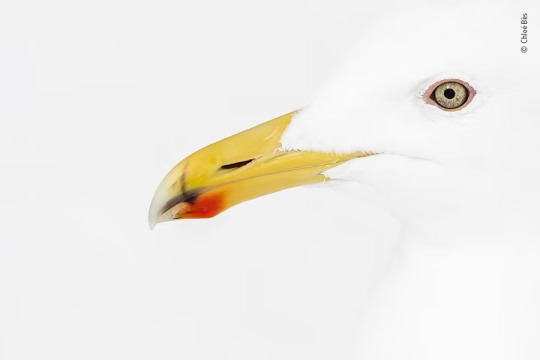
Red and Yellow. Near Rausu port, on the Japanese island of Hokkaido, several hundred glaucous-winged gulls waited for the return of fishermen. It was the beginning of March and freezing, and the air was full of the raucous calls of the gulls overhead. Some of the birds began to settle, keeping their eyes on the horizon. Focusing on one bird, Chloé Bès composed a minimalist portrait, highlighting the eye and the beak. The red spot on the beak develops when gulls are adult and is in part a reflection of their health. © Chloé Bès/Wildlife Photographer of the Year

Holding On. This leopardess had killed a monkey in Zambia’s South Luangwa National Park. The monkey’s baby was still alive and clinging to its mother. Igor Altuna watched as the predator walked calmly back to her own baby. Her cub played with the baby monkey for more than an hour before killing it, almost as if it had been given live prey as a hunting lesson. © Igor Altuna/Wildlife Photographer of the Year

World of the Snow Leopard. Against a backdrop of the spectacular mountains of Ladakh in northern India, a snow leopard has been caught in a perfect pose by Sascha Fonseca’s carefully positioned camera trap. Thick snow blankets the ground, but the big cat’s dense coat and furry foot pads keep it warm. Fonseca captured this image during a three-year bait-free camera-trap project high up in the Indian Himalayas. © Sascha Fonseca/Wildlife Photographer of the Year

In a Flap, Queensland, Australia 🇦🇺! ‘The far eastern curlew is the largest migratory shore bird in the world, and is listed as critically endangered in Australia. They start their life in Russia and north-eastern China before flying to Australia, where they rely on the intertidal mudflats for food and habitat. This image was taken in Wellington Point, Queensland, three hours before the high tide.’ Photograph: Manoj Kutty Padeettathil Manilal
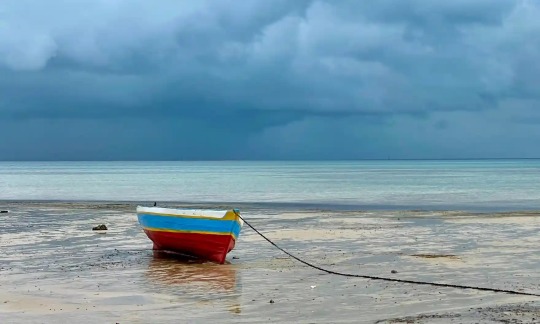
Storm Brewing, Mozambique 🇲🇿! ‘Rainy skies closing in on a local fisherman’s boat on Bazaruto Island, Mozambique.’ Photograph: Terry Dunnem
0 notes